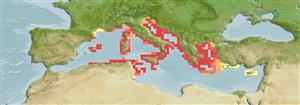Environment: milieu / climate zone / пределы глубины / distribution range
экология
морской; пресноводный; солоноватоводный донно-пелагический; pH range: 6.5 - 7.5; dH range: 8 - 10; немигрирующий. Subtropical; 10°C - 24°C (Ref. 1672); 46°N - 34°N, 2°E - 36°E
Europe: France, Italy, Slovenia, Croatia, Albania, Greece and Montenegro. Mediterranean basin: North Africa from Egypt to eastern Algeria, sometimes in landlocked basins; through the Suez Canal into the Bitter Lakes, Egypt (Ref. 3788). Asia: Turkey.
Size / Вес / Возраст
половая зрелость: Lm ? range ? - ? cm
Max length : 6.8 cm TL самец/пол неопределен; (Ref. 42455)
Краткое описание
определительные ключи | морфология | морфометрия
членистые (мягкие) лучи анального плавника: 9. Can be diagnosed from other species of Aphanius, Valenciidae and Fundulidae in Europe by having the following characters: males have pale yellow to yellow-orange caudal fin, in some populations with a wide dark submarginal bar, 8-15 dark blue to grey bars on a silvery background, bars usually regularly shaped and set; females possess 11-17 short dark brown bars on sides, over a faint greyish midlateral stripe, 24-29 scales in midlateral series on body, and pectoral fin with 14-15 rays (Ref. 59043).
Body shape (shape guide): fusiform / normal.
Occurs in coastal lagoons and in hypersaline to shallow still to slow-flowing fresh water, especially at river mouths (Ref. 59043). A short-lived species which inhabits ponds, ditches and swamps. Feeds on invertebrates and plants. Spawns from April to September (Ref. 26100). Spawning takes place on the bottom and in submerged vegetation (Ref. 59043).
Threatened due to habitat destruction and the introduction of other species (Ref. 26100). Not a seasonal killifish. Is difficult to maintain in the aquarium (Ref. 27139).
Freyhof, J. and B. Yoğurtçuoğlu, 2020. A proposal for a new generic structure of the killifish family Aphaniidae, with the description of Aphaniops teimorii (Teleostei: Cyprinodontiformes). Zootaxa 4810(3):421-451. (Ref. 126233)
Статус Красного Списка МСОП (Ref. 130435: Version 2025-1)
Угроза для людей
Harmless
Использование человеком
рыболовство: интереса не представляет; аквариум: коммерческий
дополнительная информация
инструменты
Специальные отчеты
Скачать в формате XML
ресурсы в Интернет
Estimates based on models
Preferred temperature (ссылка
123201): 17.6 - 20.1, mean 18.9 °C (based on 346 cells).
Phylogenetic diversity index (ссылка
82804): PD
50 = 0.5312 [Uniqueness, from 0.5 = low to 2.0 = high].
Bayesian length-weight: a=0.00977 (0.00817 - 0.01170), b=3.24 (3.19 - 3.29), in cm total length, based on LWR estimates for this species (Ref.
93245).
Trophic level (ссылка
69278): 2.7 ±0.27 se; based on food items.
устойчивость к внешним воздействиям (ссылка
120179): высокий, минимальное время удвоения популяции до 15 месяцев (K=0.16-0.22 questionable; assuming tm<1).
Fishing Vulnerability (Ref.
59153): Low vulnerability (10 of 100).
🛈
